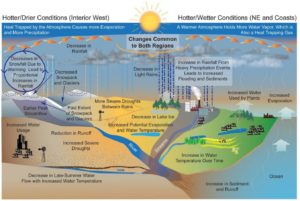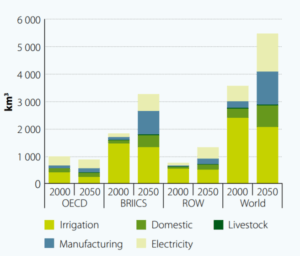Who pays for the inefficient use of resources in our business models: Businesses or the environment? Actually, both of them do.

Climate Change is drastically reducing the availability of natural resources such as fresh water, threatening the survival of entire economic systems and increasing tensions between geopolitical powers. General Electric is playing a key role in moving entire industries towards sustainability by minimizing resource consumption through the development of ultra- efficient technologies in drinkable water and wastewater treatment.
The sustainable development of societies depends on the availability of clean fresh water sources. We need water for human consumption and all productive activities such as agriculture, manufacturing, health care, energy production, amongst many others. The demand for freshwater supply has been intensified by the rapid growth of cities and industries. These uses create stresses on the freshwater supply, stresses that are amplified by the effects of climate change by widening the gap between the availability of surface water and groundwater resources and the demand for them[1].
Exhibit 1 – How Climate Change Affects Water Distribution
In fact, according to the United Nations World Water Development Report, global water demand is projected to increase by 55% by 2050 and the global water deficit is projected to be 40% by 2030. Amongst the main factors contributing to freshwater shortages are urbanization and migration patterns, industrial growth rates and climate change[2]. Additionally, the scarcity of freshwater supply increases the likelihood of violent conflicts due to intensifying competition for water amongst sectors and forced migrations[3].
Exhibit 2 – Water Demand Per Use in 2020 and 2050
The increasing need for cities and businesses to adapt to these new pressures is creating a market for technologies that maximize operating efficiencies and General Electric (GE) is at the cutting edge of that trend. Actually, GE has already invested US$ 15 billion and projects an investment US$ 25 billion by 2020 in R&D for cleaner technology[4]. In particular, GE’s water division called Water & Process Technologies, is already providing products and services across eleven industries with clients ranging from municipalities to mining companies[5]. However, the most revolutionary of those technologies is “Digital Water Solutions”.
Digital Water Solutions is the application of technology to monitor and manage infrastructure water systems, thereby improving water availability and quality for municipal utilities and end users. The impact of optimizing our water utility systems can be enormous. In fact, there are over 240,000 water pipeline breaks per year in the U.S. and those breaks, plus general leakage in the systems, account for a loss of 2.1 trillion gallons of drinkable water every year[6]. Usually, when we think of solutions for our ever more common water crisis we immediately think of building more reservoirs and drilling more wells but this only exacerbates the problem. Actually, the way to go is to optimize the existing systems and get more water by wasting less of it.
Operating a water utility system can be extremely complex with several water and wastewater treatment plants, thousands of miles of pipelines and millions of user connections. Utility companies are realizing that they need to make their assets perform better and GE’s integral digital solution intends to accomplish just that. GE has developed an integral solution comprised of hardware, software, data analytics and algorithms that allows the utility companies to regulate the entire system from a centralized location and actually predict when and where potential system failures could occur[7].
Despite the huge positive potential that Digital Water Solutions could have on reducing the loss of treated water and consequently the demand on freshwater supplies, it is still an expensive solution and it does not make economic sense for all utility companies. According to Ralph Exton, Chief Marketing Officer at GE Water, for large utility companies the breakeven on the investment can be achieved in 24 months but there is certainly a capacity threshold where it does not make sense to the utility company[8]. If this technology is to have a worldwide impact, particularly in developing regions of the world which are the most vulnerable to the threats of climate change, GE has to find a way to make it economically viable for small scale utility companies with less resources.
Nonetheless, while technologies such as Digital Water Solutions continue to evolve, who is going to pay for the inefficient use of resources in our business models?
(Word Count 787)
[1] “Climate Impacts On Water Resources,” US Environmental Protection Agency,
https://www.epa.gov/climate-impacts/climate-impacts-water-resources#Overview , Accessed November 2016.
[2] “Water For A Sustainable World”, The United Nations World Water Development Report 2015,
http://unesdoc.unesco.org/images/0023/002318/231823E.pdf , Accessed November 2016.
[3] “Climate Change 2014: Synthesis Report,” Intergovernmental Panel on Climate Change, 2014,
http://ipcc.ch/pdf/assessment-report/ar5/syr/AR5_SYR_FINAL_SPM.pdf , Accessed November 2016.
[4] “GE Powering The Future – GE Ecomagination” General Electric Sustainability,
https://www.ge.com/sites/default/files/GE_BR15_Ecomagination_Final.pdf , Accessed November 2016.
[5] General Electric Water & Process Technologies Official Site,
https://www.gewater.com/emerging-trends/digital-water , Accessed November 2016.
[6] “2013 Report Card For America’s Infrastructure,” American Society Of Civil Engineers, 2013,
http://www.infrastructurereportcard.org/water-infrastructure/ , Accessed November 2016.
[7] “GE Pushes The Envelope On Digital Water Solutions,” Global Water Intelligence Magazine, August 8th, 2016
[8] “GE Pushes The Envelope On Digital Water Solutions,” Global Water Intelligence Magazine, August 8th, 2016





It’s great to see GE taking an active role in water conservation. But, is optimizing existing water infrastructure the long-term solution, or is it just a near-term fix? I agree that using the same old approaches to accessing water (e.g., drilling wells) aren’t the solution, but can we think of more creative approaches? For example, a non-profit called XPRIZE recently launched a contest which will award $1.75M to participants who create a device that can extract water from the atmosphere in a cost-efficient way. (article link below)
http://www.theverge.com/2016/10/24/13358120/xprize-competition-water-abundance-womens-safety
Perhaps GE can sponsor similar contests to help crowdsource innovative approaches?
To me, water shortages are perhaps the scariest of climate change / resource shortage issues I know of.
Cap-and-trade agreements have made certain carbon emission reduction technologies more viable,
Tax credits make solar and wind more viable;
Is there anything being done about water that could boost adoption for a system like this?